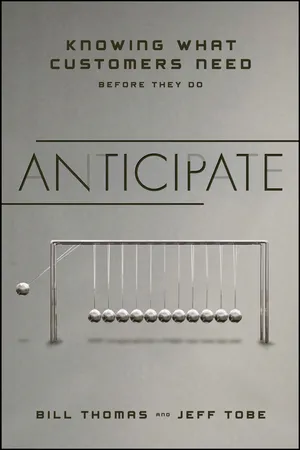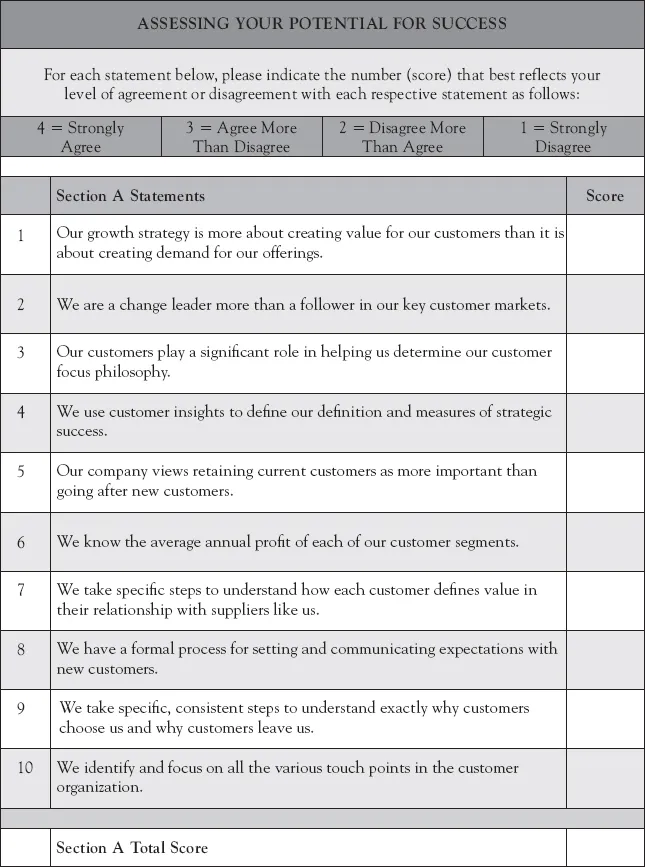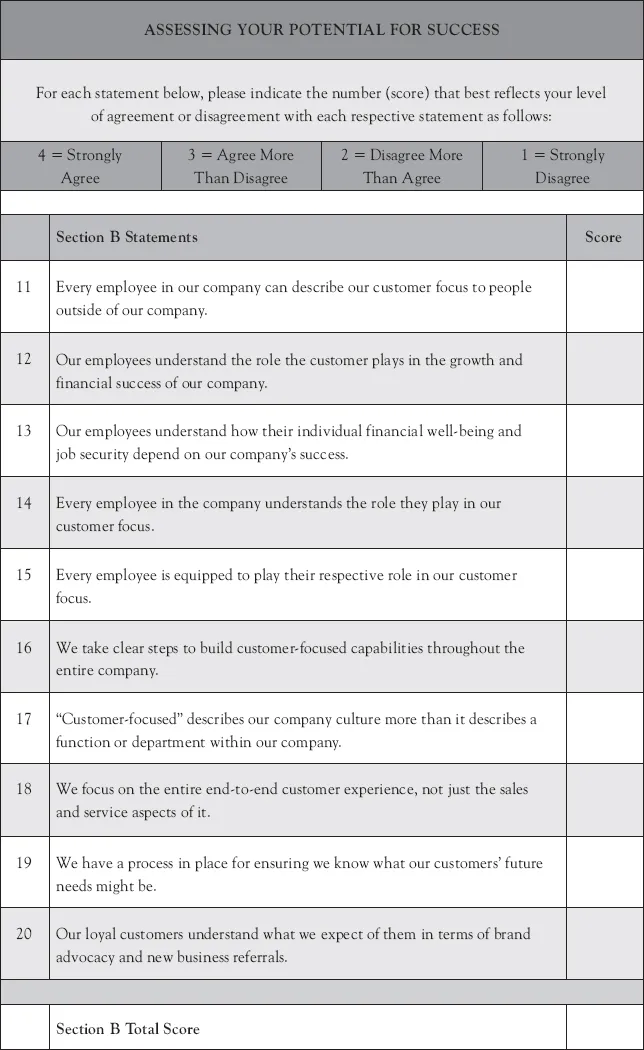![]()
Chapter 1
Strategy—Creating and Destroying Customer Value
- Assess your strategy’s potential for success
- Dispel common myths about strategy and its drivers
- Introduce the Customer Focus Framework and Maturity Model
It’s estimated that as many as 90 percent of strategies fail to deliver the value or results they were intended to.1 In most cases, that “value” is generally interpreted to mean shareholder value, return on capital employed, or some other proxy for a predictable and dependable return on investment. Some of those failures are significant, some are modest, and some are incremental—but in all cases, the feeling is . . . they could have done better.
Our experience shows two main reasons why strategies fail to deliver as promised. They were either faulty in design, or they were faulty in implementation. And oftentimes, it’s some of both. This holds true whether you’re trying to develop a broad business strategy or a more specific customer focus strategy. Chances are, if your organization has a formal customer focus strategy, you feel pretty good about its chances for success. And if you personally played a role in designing that strategy, you’re most likely feeling quite bullish about it. Let’s see. The following pages contain a brief assessment that will give you some insight into what you might realistically expect about your customer focus strategy’s likelihood of success.
Assessing Your Strategy’s Potential for Success
This self-assessment is meant to help you evaluate the potential for success of your business growth strategy and its underlying customer focus. Generally, the higher your score in a given question or area, the greater potential your organization has of succeeding in its customer focus efforts—thus generating the growth you want from your business strategy.
The thirty (30) questions address various aspects of the Customer Focus Maturity Model® (CFMM) and 10-Point Customer Focus Framework, which will be covered in great detail throughout this book. We’ve chosen questions that represent a wide range of customer focus critical success factors, but it is not meant to be an exhaustive or all-inclusive list of such questions.
NOTE: There are no right or wrong answers, only the answers that most closely reflect your company’s current state. Some of the questions may sound similar, so please read them carefully to understand the difference they’re meant to capture. You may struggle a bit on some of them trying to differentiate between a specific department or function in your company and the company as a whole. For this assessment, we are focusing on your company as a whole. Reflect the answer that most closely describes your views about the entire company. Once you have answered all thirty questions, there are instructions at the end of the assessment to help you through the next steps.
To begin, for each question, indicate which answer most appropriately reflects your current view of your company (note we use the term “company” to mean both for-profit and non-profit organizations).
Access this assessment online at www.ANTICIPATEtheExperience.com/assessment or scan the QR code.
Once you’ve recorded your answer for each of the thirty questions, add up your totals for sections A, B, and C, as well as your Grand Total Score. Then look to the comments below to understand the implications of your ratings.
Questions 1–10 examine the strength of your company’s customer-strategy connection and your focus on the unique sources and drivers of customer value as a growth enabler. These questions generally correspond to Level I of the Customer Focus Maturity Model® and tie most closely to steps 1–3 of the Ten-Point Customer Focus Framework.
Questions 11–20 examine the extent to which your people are trained, equipped, and inspired to understand and do their part in creating and leveraging loyal customers. These questions generally correspond to Level II of the Customer Focus Maturity Model® and tie most closely to steps 3–7 of the Ten-Point Customer Focus Framework.
Questions 21–30 examine the steps you take to create a customer-focused culture that consistently generates the mutual profitability of true value chain partnerships. These questions generally correspond to Level III of the Customer Focus Maturity Model® and tie most closely to steps 8–10 of the 10-Point Customer Focus Framework.
Look at your scores for each of the three areas, and see which area(s) you might have the most room for improving relative to another. You can pay particular attention to the relatively weaker area(s) as you proceed through the book.
You can also look at your Grand Total Score. Generally speaking, we find that companies’ scores for this assessment correspond to the following maturity levels in the Customer Focus Maturity Model® (CFMM):
Scores Less than 75 = CFMM Level I
Scores Between 75 and 104 = CFMM Level II
Scores Between 105 and 120 = CFMM Level III
Anticipate is about identifying selected customers or customer segments, and taking specific steps to move them along your Customer Focus efforts to increasingly more mature levels; with the ultimate goal of gaining the mutual profitability associated with Level III relationships.
As you’ll see in our early discussions, we don’t believe a business strategy, if it truly is intended to drive growth and create value, will succeed unless it is built on the design and implementation of a strong customer focus. To better appreciate why and how organizations miss out on creating value, let’s look at some commonly held beliefs about the customer–strategy connection.
Debunking Some Key Myths
One thing about commonly held beliefs: They don’t always reflect the reality of the situation, or the wisdom to recognize it.
Myth #1: A Strategy Must Inspire Your People
First and foremost, at the heart of, and running throughout, any worthwhile business strategy must be the goal of creating customer value. It’s not the shareholders, C-level executives, or board members that tell you whether or not your strategy was successful. It’s your customers—and the decisions they make each day about your products and services and those of your competitors—that determine your strategy’s success. It’s those customer decisions that translate into sales, profits, and your ultimate return on investment. A good strategy must and should inspire your people—but it first must inspire your customers to act. If it doesn’t, then you end up with an inspired organization that isn’t as successful as it wants to be. If your desired end state is to be happy or inspired, regardless of your business’s success, then you don’t need a strategy. It’s pretty easy to end up happy, but broke.
To make customers act, an effectively designed strategy must recognize that growth isn’t about finding new customers for your products and services as much as it is about finding new ways to create value for your customers (both existing and prospective customers). That value often comes from being able to identify and meet the customers’ unmet, unstated, and unknown needs better than, or before, your competitors do. And that ability comes from building and leveraging a relationship and sense of partnership with a customer that uniquely positions you to anticipate future value streams that mutually profit both sides.
Myth #2: Not All Strategies Produce Change
They better! If they don’t . . . why bother?
Without getting bogged down in theory or academic definitions, a strategy is about the decisions an organization makes, that when implemented, create the most value over time. Strategies are about creating new, more productive, faster or cheaper, more unique, or more sustainable sources of value. Their core purpose is to create a future state that’s better than the current state. They are every bit about change!
And that is precisely one of the reasons strategies often fail or underperform in implementation. Companies fail to recognize the extent to which a strategy requires change—change in culture, change in leadership practices, change in customer-facing processes, change in customer decisions, change in employee behaviors, change in business systems, and so forth. Strategies are about anticipating where the next value-creating opportunities might be in the marketplace, determining what changes the company might have to make to exploit those opportunities, and then ensuring the company has the capabilities needed to execute them effectively. We’ll spend a significant amount of time understanding and addressing the change factors—both those that accelerate and those that frustrate—in the implementation of an otherwise sound growth strategy.
Myth #3: Strategies Must Be Achievable
Unfortunately, many organizations first determine what they can afford, or what their current capabilities are, and then use those parameters to shape (limit) their strategic ambitions and choices. So “achievable” often first becomes a question of being affordable or readily doable. We disagree with that thinking in two very important respects.
First of all, no strategy should be developed in a vacuum. A company’s financial capacity must certainly be a key consideration because no company has enough money to tackle all the things they want to tackle at a given point in time. There’s only so much money to go around. But too often the financial considerations come into play before the rigorous market considerations, or they’re considered simultaneously. Either way, the outcome is usually a strategy that was based more on affordability than on market opportunity.
An effectively designed strategy must first be based on an unrestricted, blue-sky search for the most promising market opportunities or investment options we might pursue. Some of those options might be totally out of reach financially, but they should still be on the long list of strategic possibilities. Once that long list is developed, then financial considerations can come into play to help prioritize which of the options on the long list we can afford to pursue. It’s a cart-before-the-horse kind of situation. We shouldn’t look at what we can afford first and then look for options that fit within those financial parameters. We should develop our list of most optimal options first, and then see which ones we can afford—which ones have the most favorable cost-benefit value. It might seem like a play on words, but it’s a very real and significant mindset that can mean the difference between a breakthrough strategy and a benign strategy. (See Figure 1.1.)
Secondly, we agree a strategy must be doable, but we also believe it must represent some degree...





